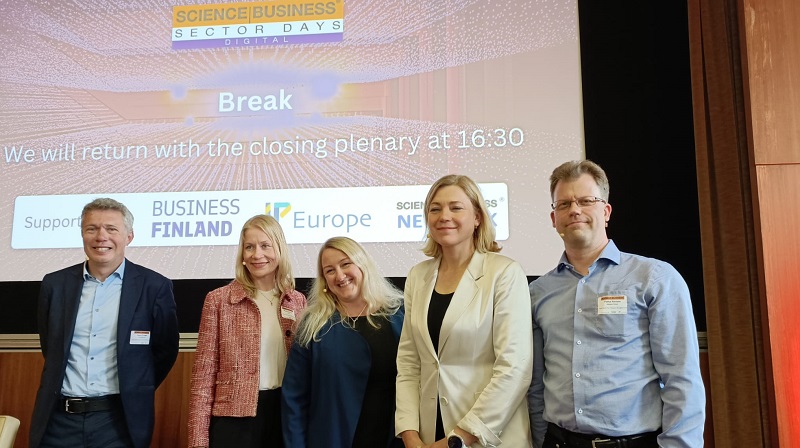Building the Future: Europe's Quest for Technological Leadership in 6G

Second from left to right: Ms. Maarit Palovirta, Ms. Maiju Gyran, Ms. Henna Virkkunen, Mr. Pekka Rantala.
The Science Business Sector Days event "Europe in the digital world," held on May 22-23, featured prominent panel discussion joined by representatives from Business Finland and Academy of Finland on the revolutionary network expected to roll-out in the 2030s. The panel emphasized the importance of staying ahead of the curve to secure a leading position in the in the 6G era.
While the deployment of 5G is expected to continue for several years to come, the research has moved ahead to create the digital infrastructure of the future. 6G will be able connect billions of diverse devices simultaneously with 100 times faster speed than 5G, providing wider network coverage, improved reliability, and ultra-low latency. The emerging technology brings an estimated of 35-fold-increase in business potential compared to 5G. This will create growth and jobs that Europe needs.
Impacts of 6G
Pekka Rantala, Head of the 6G Bridge program at Business Finland, encapsulated the future of 6G's into three impact areas: people, sustainable development, and productivity.
The 6G Bridge program aims to make Finland the global leader in providing new value with 5G Advanced and 6G technologies for sustainable industries and societies.
In the 6G era there will be 3 billion new internet users, resulting in an estimated total of 8 billion connected users. The access to essential services for these 3 billion people will result in substantial benefits for them and to the world by harnessing the power of their collective intelligence.
In the context of sustainable development, 6G will help to reduce electricity consumption and help industries, cities, and municipalities to meet their Sustainable Development Goals (SDGs). Furthermore, 6G will increase productivity by combining physical and digital world with human interaction, opening wide-scale business opportunities. Cloudification and softwarization of networks will enable the launch of new AI-supported services, enabling more efficient and dynamic network management.
An example of what 6G can deliver in the long run could be a body area network (BAN), capable of connecting various electronic devices worn, affixed, or implanted to a user. The collected information transferred to a digital twin has the potential to transform healthcare and enable the development of immersive technologies, including virtual and augmented reality. The network will not be limited to data transmission and can be utilized in intelligent sensor technologies cross various sectors and applications, such as security systems.
Private-public investments requisite for 6G revolution
There is still substantial amount of work to solve the technological hurdles ahead, which are related to hardware and software, advanced materials and AI-development and integration. The network must be scalable and flexible to accommodate diverse use cases and requirements while minimizing energy consumption.
To truly advance Europe's technological sovereignty and competitiveness EU investments are crucial.
Maintaining control over the critical infrastructure of the EU should be a top priority. The consensus with the panelists was that valorization of 6G will only be made possible with sufficient investments from both private and public sectors.
Panelist Henna Virkkunen (MEP) stressed the need for investments in infrastructure and research to foster leading projects, while the emerging regulatory framework should incentivize both private and public investments in 6G. The foundation for success depends on national funding for education and skills.
Maiju Gyran, Senior Science Adviser of Academy of Finland, highlighted the role of public-private partnerships in establishing competence clusters that foster impactful cooperation. These ecosystems will also accumulate expertise for education. The 6G Flagship, funded by the Academy of Finland and University of Oulu, is an exemplary illustration of public-private partnership that carries groundbreaking frontier research on 6G.
Partnerships and projects are needed to bridge the gap between research and commercialization. Teleoperators need to see concrete demand and use cases for deploying 6G, told Maarit Palovirta, Senior Director of the European Telecommunications Network Operators' Association (ETNO).
Global standardization
Before the commercialization of 6G can become a reality, it is essential to address regulatory and technical issues within the global context. Peter Stuckmann, Head of Unit for Future Connectivity Systems at DG CNECT of the European Commission, stated that the conception phase of 6G is underway for developing a roadmap in collaboration with stakeholders in The European Smart Networks and Services Joint Undertaking (SNS JU) and with like-minded international partners. Once this phase is complete, progress can be made towards global standardization in the mid-2020s. One key issue is deciding the spectrum allocation for 6G.
The EuCNC & 6G Summit held in June will be an opportunity for Europe to lead the global conception of 6G. Rantala suggested that taking leadership in 6G will allow us to steer the development of the technology in accordance with European values, rather than allowing global competitors to dictate the direction. By being the forerunners in the EU, we can reap the benefits of tomorrow.
Read more
Recording of the event: The future of connectivity: Is Europe ready to lead the 6G race? – Digital Sector Day
